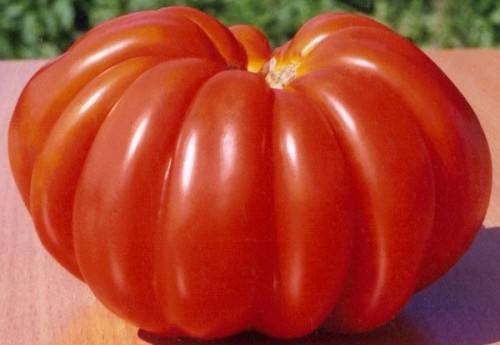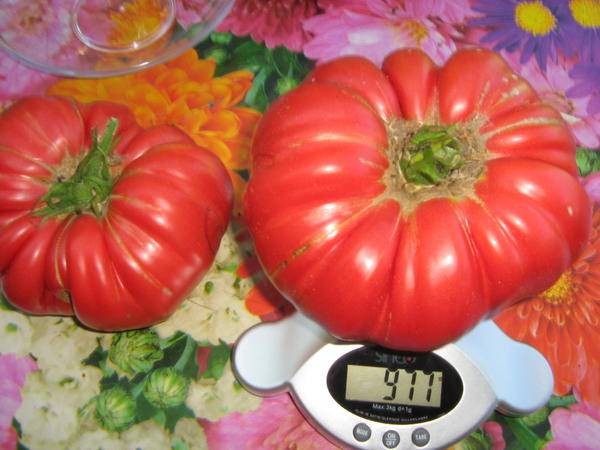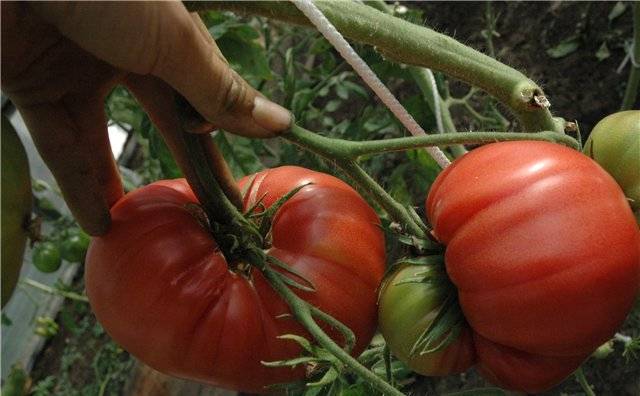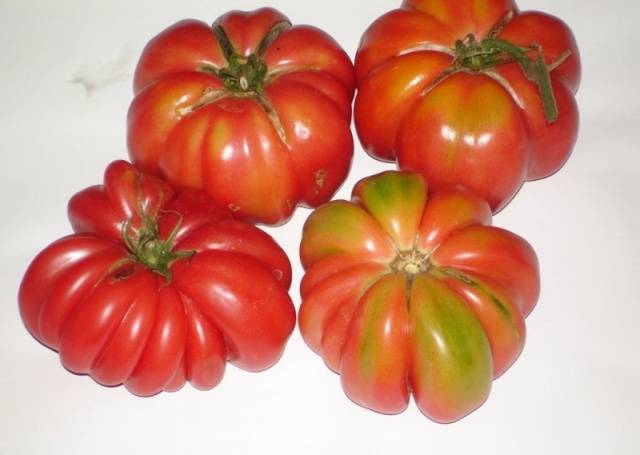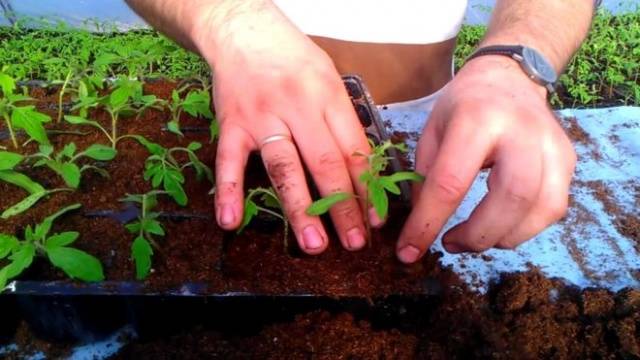Content
Someone might think that the "Japanese crab" is a new species of crustaceans. In fact, this name hides one of the best varieties of tomato. It was relatively recently bred by Siberian breeders. The salad variety has a lot of advantages and quickly fell in love with many farmers. Its seeds are available to everyone, but for the successful cultivation of a crop, it is necessary to know some of the features of agricultural technology. For those who are interested in the variety, we propose to get acquainted with the characteristics and descriptions of the Japanese crab tomato variety, as well as the peculiarities of its cultivation.
Description of vegetables
Tomato "Japanese crab" can be called the best among many other varieties. It is distinguished, first of all, by its interesting, bright taste and aroma. The variety is ideal for making salads, sandwiches and other cold snacks. Large vegetables are very fleshy and contain little free juice. Their average weight is 300 g, but some especially large fruits reach a mass of 800-900 g. The giants of the "Japanese crab" variety can be seen in the photo below:
Tomatoes of the "Japanese crab" variety are flattened, their surface is ribbed. There are 5-6 small seed chambers inside the tomato. The color of vegetables changes as they ripen from green to bright red or crimson. A dark spot typical of this variety can be seen near the stem of the tomato.
Tomatoes have a dense skin that prevents the fruit from cracking. It is able to preserve the integrity of even the largest tomatoes. But despite its strength, the skin of the Japanese crab tomato is rather tender and homogeneous. It is almost invisible when consuming fresh vegetables.
Comments and reviews of the farmer-taster about tomatoes of this variety can be found by watching the video:
The video perfectly demonstrates the external qualities of Japanese crab tomatoes grown in a greenhouse.
The purpose of tomatoes is universal. They can be used to prepare snacks, various culinary dishes or canning winter preparations. Large vegetables are difficult to fit into jars, so they must be divided into parts before harvesting. Fleshy tomatoes are great for making ketchup or pasta. The juice from the Japanese crab tomatoes is quite thick.
Plant features
Speaking about the characteristics and description of the Japanese crab tomato variety, it is worth mentioning not only the quality of the vegetables themselves, but also the bushes that will have to be grown in order to get a good harvest of delicious fruits. So, the bushes of the "Japanese crab" variety are indeterminate, tall. Their height in favorable conditions of the greenhouse reaches 2 m. To increase the yield, these giants must be correctly and timely formed into one or two stems. It is worth noting that the proposed variety can be cultivated not only in a greenhouse or greenhouse, but also in an open garden. In unprotected conditions, tomatoes must be carefully tied to a reliable support.
Indeterminate bushes form fruiting clusters throughout the growing season. The first inflorescence usually appears above 7-8 leaves of the plant. Each brush contains about 6-10 simple flowers.To obtain larger fruits, experienced gardeners pinch the brushes, leaving only 4-5 flowers.
The plant forms numerous stepchildren, which must be removed in accordance with the chosen tomato formation scheme. It is also recommended to pinch the main shoot about a month before the end of fruiting. This measure will speed up the ripening process of already existing fruits.
Tomato leaves of the proposed variety are medium-sized, light green in color. It is customary to remove the lower leaves of indeterminate tomatoes so that the plant can correctly distribute nutrients.
Stepsons and leaves removal measures for all indeterminate tomatoes are similar and must be carried out according to certain rules, which can be learned in detail from the video:
Ripening period and yield of the variety
Siberian breeders, creating the Japanese crab tomatoes, first of all, took into account the peculiarities of the climate existing in the region. So, the proposed variety of tomatoes has a medium-early ripening period. From the day of sowing the seed to the day of harvest, about 110-115 days should pass. Such a ripening time allows you to grow tomatoes not only in seedlings, but also in a non-seedling way.
The first tomatoes of the proposed variety ripen in 2.5-3 months after sowing the seeds. They are characterized by a particularly large size and can weigh 500-600 g. The yield is generally quite high: with good care, more than 5 kg of vegetables can be harvested from each bush. Productivity from 1 m2 land exceeds 15 kg. The fruiting process of the variety is limited, as a rule, by climatic conditions. In the greenhouse, however, indeterminate tomatoes can yield until November.
Resistance to external factors
Often, gardeners, growing tomatoes in a greenhouse or on an unprotected garden bed, are faced with various diseases and pests that can significantly spoil the crop or completely destroy it. The variety "Japanese crab" is genetically resistant to many ailments. So, he is not afraid of top and root rot, tobacco mosaic. For other diseases, tomatoes do not have a high immune defense, so it is worth remembering:
- Prolonged rains and sudden cold snaps can provoke the development of late blight.
- Conditions with high temperatures and high air humidity, which is typical for a greenhouse, can be a prerequisite for the development of cladosporia.
The development of late blight and cladosporiosis can be prevented by prophylactic means. For example, treating plants with ash or trichopolum once every 3 days will prevent fungi and viruses from spreading. When detecting foci of the disease, it is recommended to use special drugs. So, you can fight late blight with fungicides. Copper-containing preparations can resist cladosporium disease.
The variety has no genetic resistance against insects. They must be fought with folk remedies in the form of an infusion or decoction, as well as by setting traps.
Growing features
"Japanese crab" is a very grateful variety that can produce a good harvest of vegetables only with proper care. The variety requires special care and attention from the first days of cultivation. So, before proceeding with the cultivation of tomatoes, it is important to determine the time and place of planting the seeds:
- tomato seeds can be sown in a heated greenhouse in early April;
- in an unheated greenhouse, favorable conditions are established by the beginning of May;
- it is recommended to sow grains in open ground in late May - early June;
- at home for seedlings, tomato seeds are usually sown in early April.
It is worth noting that tomato seeds are not afraid of the cold and can be sown in open ground early enough, but this will not speed up the process of fruit ripening, since the germination of the seeds will occur only after the weather is favorable. When growing seedlings at home, you also need to pay special attention to the date of planting the seeds, because in favorable conditions the plants can grow quite quickly and exceed the recommended parameters by the time they are planted in the ground.
For different regions of the country, the timing of sowing seeds for seedlings may vary. It is recommended to sow seeds for seedlings 60 days before the day of the proposed planting of seedlings in the ground. At the time of planting, tomatoes should have 6 true leaves and a stem height of about 20-25 cm.
It is necessary to place seedlings in open ground or in a greenhouse according to a two-row or checkerboard pattern. 1 m2 the soil should have no more than 3 indeterminate plants. Caring for Japanese crab tomatoes is standard, including watering, loosening and weeding the soil. Fertilizers need to be applied regularly, at least 4-5 times during the entire growing season. It should be remembered that nitrates can accumulate in ripe fruits, therefore, at the stage of active ripening of tomatoes with dressings, you need to be careful.
Advantages and disadvantages
The variety "Japanese crab" has a lot of advantages:
- amazing taste of fruits and their size;
- high productivity;
- unpretentiousness of the variety, the ability to grow tomatoes in open and protected conditions;
- excellent external qualities of tomatoes;
- universal purpose of vegetables.
In addition to important advantages, the variety "Japanese crab" also has some disadvantages that should be remembered:
- Poor storage suitability of tomatoes.
- Vulnerability of ovaries to adverse conditions. Flowers and ovaries at a temperature of + 2- + 40C can fall off.
Outcomes
Thus, we can say with confidence that "Japanese crab" is an excellent salad variety of tomatoes, with excellent characteristics of taste and high external qualities of the fruit. This is confirmed by numerous reviews and a description of the variety. It is quite simple to cultivate tomatoes if you know some of the features and rules of agricultural technology. We tried to tell about them in detail above in the article, so that every willing farmer has the opportunity to grow a good harvest of delicious tomatoes with his own hands.
